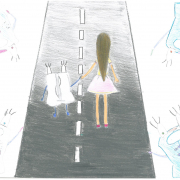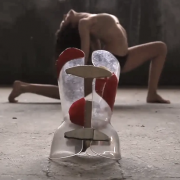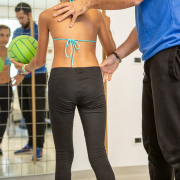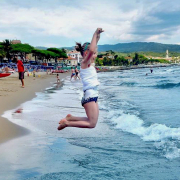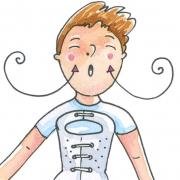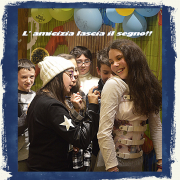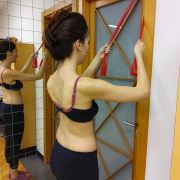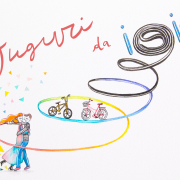Our very best wishes for Christmas and 2020: a whole new year for each of us to “shape” as we like!
Our greetings come to you with a story.
More than just a trip down memory lane (to the bike rides and dripping lollipops of our youth), “Liquorice Wheels” is a story of hope: a reminder that things work out for the best, most of the time!
Thanks to Roberto Angero, father of a young Isico patient, who shared with us “his” story and we want to share this story with you as our Christmas Carol for this year.
Liquorice Wheels
Every kid in town would stop to watch him, especially when he reared up for more than a dozen consecutive pedal turns. He could do that – we counted them! He would lift his BMX like a tamed horse and then, balancing on the back wheel, would twist the handlebars, first right and then left. He could steer while rearing, too, and even jump up onto the pavement.
In the afternoon, after homework, we would wait for him on the playing field. He was always the last to appear, and you couldn’t leave without him. Simone was the one with the best bike — the best not because it was new, but because it had belonged to his cousin, who had been in a gang war.
That’s what he used to tell us at least. Simone showed us all the scratches the bike had acquired during various raids, but the thing that amazed us was that sticker on the crossbar with “Iron Maiden” written on it. Simone told us that only gang leaders had that sticker. I believed it because I once saw one on my brother’s friend’s Vespa. Surely, he must have been a gang leader, too, because everyone else just had a Garrelli scooter, and no sticker! Once everybody had arrived at the playing field, we could leave, with Simone in the lead. Elisa, who had a Graziella (ladies’ bicycle), was the prettiest in the group, but she would only ever talk with Simone, and sometimes with Sandrino, too. Filippo, instead, rode a red Saltafoss (mountain bike) with a gearbox, and I remember that he used to make us laugh a lot because he could imitate all our teachers.
Then there was Tommy, who always brought the ball, which he kept in a plastic bag hanging from his handlebars. Jessica, meanwhile, used her mother’s bike, which had a basket, and she could barely reach the pedals. I remember she wasn’t as pretty as Elisa, and she also wore a strange body brace because she said she had a crooked back, but she always had a great supply of sweets. Sandrino was always the one with a new bike — he used to say that his father was rich —, but he never let anyone have a go. On just one occasion he let Elisa have a ride in exchange for a kiss on the cheek, but that was the one and only time. He was very possessive with his belongings.
The group also included Carlo and Marco, the “little twins”, who were inseparable. They had identical bikes, and they both rode one-handed because the other hand was always holding a lollipop, which dripped to the elbow. Actually, they weren’t twins at all. They had been friends since kindergarten, but they did look very similar, maybe because of all the time they spent together! Then there was me. With my gold coloured bike. Always bringing up the rear.
Simone usually led the group, and we all fell in behind him, including me, of course. We moved in single file, except for Carlo and Marco, who rode side by side. Whenever Simone decided to go faster, we all had to speed up, but we made sure we never overtook him. We used to go round town that way. Our town, Somma, seemed very little at the time, and we felt like the whole place belonged to us.
There was a group of younger kids that we often encountered, and when we did Simone would rear up, leaving them astonished. On the other hand, we were always careful to avoid the older groups. We were scared of them, although Simone always said that they would never stick around if his cousin were with us! Our bike ride usually ended up at Paradise Street, which was legendary! It was a hilly road that made for a thrilling ride. We would all stop at the top of the first hump. We kept in line, except for Marco and Carlo, and no one ever went before Simone did. The second to go was always Filippo, who would imitate our maths teacher as he careered headlong down the hill, leaving us doubled up with laughter. Brilliant!
Gradually, all the others followed suit, racing down like there was no tomorrow. Jessica and I, on the other hand, almost never took part because we were afraid of falling off. Well, I was afraid of falling off. Jessica didn’t want to ruin her mother’s bike, or so she said! So, we would wait for the others, eating sweets together. After Paradise Street, we would make our way to the playing field. Tommy would get the ball out, while Simone and Filippo formed the teams. These were never even, of course. I always ended up with Marco, Carlo and Jessica. They weren’t much good at football and, what’s more, they always put me in goal. The other team always scored loads of goals, and at the end of the match Simone would tell me I had been lucky because, if his cousin had been there, they would have scored many more. And I let myself believe it.
In those days, evening always came far too fast. You started to hear someone’s mum calling in the distance, usually Sandrino’s, and we knew it was time to call it a day.
Simone was always the first to go home, quickly followed by Elisa. Tommy would put the football back in its bag, while Filippo would do one of his famous imitations, such as our religious education teacher in a temper, screaming at everyone in a falsetto voice.
Those were the last laughs of the evening. I had to go home, too. I usually said goodbye to Jessica first who, in exchange, gave me a liquorice wheel, while the twins went off together as usual, happily challenging each other to an armpit raspberry contest!
Today, 30 years later, sitting on a bench near those places (now gone) where we used to play, I am lost in thought. The memories of the past blend with thoughts of the present. I find myself remembering how I was always the last one and Simone the cool one.
No one would think that seeing him today: once the blond “golden guy”, now he is overweight, grizzled and balding. He doesn’t have a secure job, and is constantly looking for some “cousin” to liven up his dull life. I also thought about everyone else. For example, about Marco and Carlo, who, years later, still seek each other out just like they did as small children: a brotherly bond that will last forever. I think about Elisa, who used to run after a thousand cool guys like Simone, in the futile hope of finding her Prince Charming among them. Today, she’s still as beautiful as ever; after three divorces, she has now moved on to yet another flashy entrepreneur. Tommy hasn’t changed either: he’s just as “public-spirited” as he always was. Back then he was the one who always thought to bring a ball, now he’s the one likes to get a round of beers in for everyone, especially if Filippo is there. Filippo still loves to entertain everyone, and the more beer he drinks, the more he shoots his mouth off, cracking us all up! Unfortunately, we’ve seen little of Sandrino since his dad’s company went bankrupt, and he had to start learning to get by on his own. By all accounts, he’s not doing too well: he drives a dilapidated van now and has maybe even moved away.
And so that just leaves me. I used to feel like I was at the back of the queue in life, but now I have come to realise I am the luckiest of the bunch. I still have my old friends, but mainly I have Jessica, my lovely wife — now with a perfectly straight back —, who has been by my side all these years, making sure I’m never short of love and affection, or sweets! There’s no point hiding the fact: I’ve always been mad about her!
—


